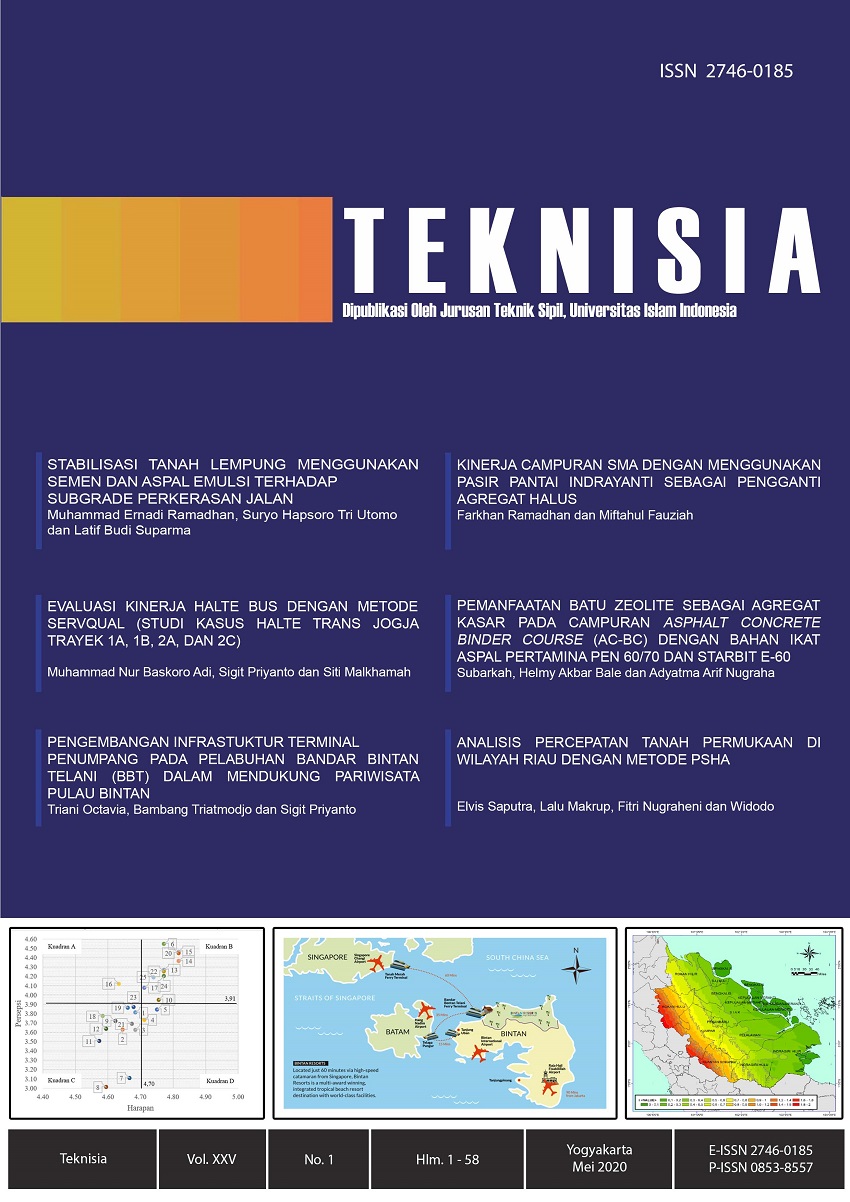Main Article Content
Abstract
An evaluation of the condition and performance of the BBT Port needs to be carried out because of the significant increase in the number of tourist visits to the Bintan Beach International Resort area. Still, since its inauguration in 1994, the port has not changed much. Passenger terminal needs are commonly defined through projections using the exponential trend method based on ship and visitor flows in the last five years. A port performance is based on BOR (Berth Occupancy Ratio) calculation. In contrast, for the performance evaluation of passenger terminal services is based on the perception of tourists as passenger terminal users obtained from the questionnaire results with a Likert scale and the Importance Performance Analysis (IPA) method from the IPA, interviews with the BBT port manager, are conducted by using the Strength Weakness Opportunities Threats (SWOT) method to formulate the development strategy. The analysis result shows that it needs to increase the waiting area up to 613 m² in 2033, and the parking area of 17,173 m², while the BOR at the BBT port is still in a proper category, by 24.11% of the UNCTAD 50% requirement. In evaluating the passenger satisfaction to the port services, the improvement focuses on the priority quadrant, namely the physical condition of the BBT port facilities. Next, formulating a development strategy in terms of physical aspects and management to adjust the passenger needs, and the BBT port is ready to face business competition in the future.
Keywords
Article Details
Under the following term:
-
Attribution — You must give appropriate credit, provide a link to the license, and indicate if changes were made. You may do so in any reasonable manner, but not in any way that suggests the licensor endorses you or your use.
-
ShareAlike — If you remix, transform, or build upon the material, you must distribute your contributions under the same license as the original.
- No additional restrictions — You may not apply legal terms or technological measures that legally restrict others from doing anything the license permits.
References
- Kementerian Perhubungan Republik In-donesia. (2004) “Keputusan Menteri Perhubungan Nomor KP. 52 Tahun 2004 Tentang Penyelenggaraan Pelabuhan Penyebrangan”. Kemen-terian Perhubungan Republik Indo-nesia. Jakarta.
- Andiani, D. (2011). “Terminal Feri Domestik Arsitektur Simbolis Medan”. Tugas Akhir. Program Studi Arsitektur Universitas Sumatera Utara. Medan.
- Arikunto, S. (2013). “Prosedur penelitian Suatu Pendekatan Prak-tik”. Jakarta : PT. Rineka Cipta.
- Debra, T. L. (2019). “Perencanaan Pengembangan Pelabuhan Manado Sebagai Pelabuhan Pariwisata”. Teknik Sipil Universitas Sam Ratu-langi. Manado.
- Putra, A. (2016). “Pengembangan Infra-struktur Pelabuhan Dalam Men-dukung Pembangunan Berkelanju-tan”. Teknik Sipil Universitas Halu-oleo. Kendari.
- Martilla, J., James, J. (1977). “Importance- Performance Analysis”. The Journal of Marketing. 41(1):77- 79.
- Rangkuti, F. (2004). “Analisis SWOT Teknik Membedah Kasus Bisnis”. Jakarta: PT. Gramedia Pustaka Utama.
- Robert, E. (2018). “Analisis Kinerja Pelayanan Pelabuhan Penyebrangan Bolok Kupang’”. Program Studi Magister Sistem Teknik Transportasi. Universitas Gadjah Mada. Yogyakarta.
- Ruslin, (2018). “Analisis Kinerja Pela-yanan Operasional Terminal Petikemas Pelabuhan Soekarno Hat-ta”. Program Studi Magister Sistem Teknik Transportasi. Universitas Gadjah Mada. Yogyakarta.
- Tjiptono, Fandy dan Chandra, G. (2007). “Service, Quality & Satisfaction”. Yogyakarta: Penerbit Andi.
- Triatmodjo, B. (2010). “Perencanaan Pelabuhan”. Yogyakarta: Beta Off-set.
- Wibisono, Y. (2015). “Metode Statistik”. Yogyakarta: Gadjah Mada University Press.
- Widyanto, Y. (2019). ”Evaluasi Fasilitas Eksisting Pelabuhan dan Rencana Pengembangan Pelabuhan Sunda Kelapa”. Program Studi Magister Sistem Teknik Transportasi. Univer-sitas Gadjah Mada. Yogyakarta.
References
Kementerian Perhubungan Republik In-donesia. (2004) “Keputusan Menteri Perhubungan Nomor KP. 52 Tahun 2004 Tentang Penyelenggaraan Pelabuhan Penyebrangan”. Kemen-terian Perhubungan Republik Indo-nesia. Jakarta.
Andiani, D. (2011). “Terminal Feri Domestik Arsitektur Simbolis Medan”. Tugas Akhir. Program Studi Arsitektur Universitas Sumatera Utara. Medan.
Arikunto, S. (2013). “Prosedur penelitian Suatu Pendekatan Prak-tik”. Jakarta : PT. Rineka Cipta.
Debra, T. L. (2019). “Perencanaan Pengembangan Pelabuhan Manado Sebagai Pelabuhan Pariwisata”. Teknik Sipil Universitas Sam Ratu-langi. Manado.
Putra, A. (2016). “Pengembangan Infra-struktur Pelabuhan Dalam Men-dukung Pembangunan Berkelanju-tan”. Teknik Sipil Universitas Halu-oleo. Kendari.
Martilla, J., James, J. (1977). “Importance- Performance Analysis”. The Journal of Marketing. 41(1):77- 79.
Rangkuti, F. (2004). “Analisis SWOT Teknik Membedah Kasus Bisnis”. Jakarta: PT. Gramedia Pustaka Utama.
Robert, E. (2018). “Analisis Kinerja Pelayanan Pelabuhan Penyebrangan Bolok Kupang’”. Program Studi Magister Sistem Teknik Transportasi. Universitas Gadjah Mada. Yogyakarta.
Ruslin, (2018). “Analisis Kinerja Pela-yanan Operasional Terminal Petikemas Pelabuhan Soekarno Hat-ta”. Program Studi Magister Sistem Teknik Transportasi. Universitas Gadjah Mada. Yogyakarta.
Tjiptono, Fandy dan Chandra, G. (2007). “Service, Quality & Satisfaction”. Yogyakarta: Penerbit Andi.
Triatmodjo, B. (2010). “Perencanaan Pelabuhan”. Yogyakarta: Beta Off-set.
Wibisono, Y. (2015). “Metode Statistik”. Yogyakarta: Gadjah Mada University Press.
Widyanto, Y. (2019). ”Evaluasi Fasilitas Eksisting Pelabuhan dan Rencana Pengembangan Pelabuhan Sunda Kelapa”. Program Studi Magister Sistem Teknik Transportasi. Univer-sitas Gadjah Mada. Yogyakarta.
